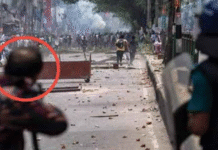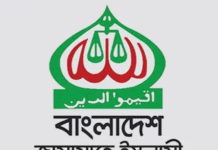

December 17, 1971, Page 1Buy Reprints
NEW DELHI, Dec. 16—India today ordered a complete ceasefire in the war with Pakistan after seizing Dacca, the East Pakistani capital, and accepting the surrender of Pakistan’s forces there.
With guns stilled by the surrender in the East, the cease fire on the western front, more than a thousand miles away, was set—without any agreement from Pakistan—to begin at 8 P.M. tomorrow, Indian time (9:30 A.M. Friday, New York time).
After 14 days of bitter warfare over the status of the Bengalis in East Pakistan, Prime Minister Indira Gandhi of India said, “It is pointless in our view to continue the present conflict.”
Pakistani Shortages Seen
But President Agha Mohammad Yahya Khan of Pakistan asserted in a nationwide radio broadcast that the war was still on “and we will continue to fight.”
A major tank battle—the largest of the war—has erupted on the western front near the little Pakistani town of Shakargarh, in the Punjab. Indian officials said India had lost 15 tanks and claimed the destruction of 45 Pakistani tanks.
- Dig deeper into the moment.
Chinese Charge Denied
Indian officials, said there had been no fighting on the Chinese border, and a Foreign Ministry spokesman described the accusation by Peking—a supporter of Pakistan—as “totally without foundation.” Nonetheless, the protest raised apprehensions here that the conflict might be widened.
India’s offensive in East Pakistan, which began in the early hours of Dec. 4, ended at 4:31 P.M. today in the total surrender of the four divisions of West Pakistani troops there.
Four senior civil servants of the Bangladesh rebel government will arrive in Dacca tomorrow to begin forming an independent government.
The surrender agreement said that “protection will be provided” by Indian forces to all Pakistani troops, foreign nationals, ethnic minorities and persons of West Pakistani origin.
India was clearly determined to try to prevent summary executions and bloody reprisals against West Pakistanis and their supporters, the Bihari Moslems, by the Bengali majority in the prewar population of 75 million. The Bengalis suffered eight months of atrocities at the hands of West Pakistani troops after trying to secede from Pakistan in March.
The surrender today was purely a military matter and not a political agreement to end the crisis between Pakistan and India. A senior Indian official said that “there are many matters to he negotiated” between India and Pakistan and between the Bengali movement and Pakistan.
One of the most important of those matters is the fate of Sheik Mujibur Rahman, the charismatic East Bengali politician who is under arrest in West Pakistan for treason.
India will exert as much pressure as possible on General Yahya to release Sheik Mujib — as he is popularly known—who has been proclaimed president by the Bengali secessionists. who call their territory Bangladesh (Bengal Nation). Indian officials fear that if he is not released chaos and a struggle for power may boil over in East Pakistan.
Indian officials. who said today that General Niazi asked that he be allowed to “regroup” his forces in “designated areas.” said they understood this to mean that he wanted to stop the fighting but to keep his troops under arms and under control of their officers.
Bombing Pause Ordered
That was unacceptable to India, which demanded complete surrender by 9 A.M. An overnight bombing pause was ordered to encourage the surrender.
General Niazi sent an answer by military radio 30 minutes before the pause was to expire. He asked for a six‐hour extension of what he called “the truce” and invited a senior Indian general to Dacca to negotiate surrender details.
Maj. Gen. J. F. R. Jacob, chief of staff of the Indian Eastern Command, went to Dacca by helicopter while Indian troops advancing from the north and northeast moved within two miles of the city.
After Generals Jacob and Niazi had initialed the surrender agreement, General Jacob’s superior General Aurora, and other Indian officers went to Dacca to sign the final agreement. The Indian delegation included the chief of staff of the Bengali rebel guerrillas known as Mukti Bahini or Liberation Force.
Then two Indian battalions and two Bengali battalions entered Dacca and began to take over from the Pakistani forces as jubilant Bengalis looked on.
In a dramatic final chapter of the war in the East, India launched her first amphibious) landing last night when a composite force of soldiers and’, sailors went ashore at the southern part of Cox’s Bazaar and overcame “light resistance to take the city.”
It was another indication of how much the Indian armed forces—once a relatively weak and ill‐armed body—had im proved in recent years, partly with Soviet assistance. In the current conflict India has employed such advanced techniques as helicopter assaults, large‐scale drops of paratroops and a naval blockade.
Mrs. Gandhi’s orders for a cease‐fire on the western front were accompanied by a message broadcast to the nation and transmitted to her Foreign Minister, Swaran Singh, at the United Nations in New York.
“We have repeatedly declared that India has no territorial ambitions,” it said. “Now that the Pakistani armed forces have surrendered in Bangladesh and Bangladesh is free, it is pointless in our view to continue the present conflict.”
Rejoicing in Parliament
The surrender in East Pakistan was greeted with wild rejoicing by members of Parliament when Mrs. Gandhi, wearing a lemon‐colored sari, announced the news.
In New Delhi, however, there was no real mass victory celebration and, by and large, people went about their normal business, though beneath their calm demeanor they evidently were brimming with pride.
While American prestige and influence in India are in ruins, the Soviet Union is enjoying high public esteem for its dogged diplomatic support and its repeated vetoes of United Nations cease‐fire resolutions.
President Yahya’s nationwide broadcast seemed to indicate that Pakistan would continue the fight in the West for now.
The opposing forces are about equal in numbers on the western border, where Pakistan has nine infantry and two armored divisions.
In the last few days the Indians have made what officials called “a major probe” into the area of Pakistani Punjab around the town of Shakargarh. and have occupied some 360 square miles of territory.
Pakistan made a “heavy counterattack” last night and today after Indian patrols continued to advance and got to the west bank of the Basantar River west bf Shakargarh. The Indians have not taken Shakargarh Town.
The Indians said they met the counterattack by sending in squadrons of tanks — there are 14 to a squadron — one after another until the number of reinforcing squadrons reached four. As a result, a spokesman said, a “big tank battle has taken place today.”









